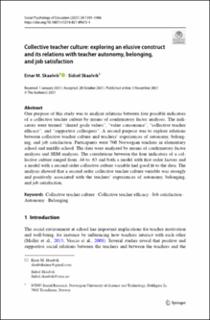| dc.contributor.author | Skaalvik, Einar Melgren | |
| dc.contributor.author | Skaalvik, Sidsel | |
| dc.date.accessioned | 2023-09-07T11:02:50Z | |
| dc.date.available | 2023-09-07T11:02:50Z | |
| dc.date.created | 2022-01-22T15:36:03Z | |
| dc.date.issued | 2021 | |
| dc.identifier.citation | Social Psychology of Education. 2021, 24 1389-1406. | en_US |
| dc.identifier.issn | 1381-2890 | |
| dc.identifier.uri | https://hdl.handle.net/11250/3087914 | |
| dc.description.abstract | One purpose of this study was to analyze relations between four possible indicators of a collective teacher culture by means of confirmatory factor analyses. The indicators were termed “shared goals values”, “value consonance”, “collective teacher efficacy”, and “supportive colleagues”. A second purpose was to explore relations between collective teacher culture and teachers’ experiences of autonomy, belonging, and job satisfaction. Participants were 760 Norwegian teachers in elementary school and middle school. The data were analyzed by means of confirmatory factor analyses and SEM analyses. The correlations between the four indicators of a collective culture ranged from .44 to .63 and both a model with first order factors and a model with a second order collective culture variable had good fit to the data. The analysis showed that a second order collective teacher culture variable was strongly and positively associated with the teachers’ experiences of autonomy, belonging, and job satisfaction. | |
| dc.description.abstract | Collective teacher culture: exploring an elusive construct and its relations with teacher autonomy, belonging, and job satisfaction | |
| dc.language.iso | eng | en_US |
| dc.rights | Navngivelse 4.0 Internasjonal | * |
| dc.rights.uri | http://creativecommons.org/licenses/by/4.0/deed.no | * |
| dc.title | Collective teacher culture: exploring an elusive construct and its relations with teacher autonomy, belonging, and job satisfaction | en_US |
| dc.title.alternative | Collective teacher culture: exploring an elusive construct and its relations with teacher autonomy, belonging, and job satisfaction | en_US |
| dc.type | Peer reviewed | en_US |
| dc.type | Journal article | en_US |
| dc.description.version | publishedVersion | |
| dc.source.pagenumber | 1389-1406 | en_US |
| dc.source.volume | 24 | en_US |
| dc.source.journal | Social Psychology of Education | en_US |
| dc.identifier.doi | 10.1007/s11218-021-09673-4 | |
| dc.identifier.cristin | 1987845 | |
| cristin.ispublished | true | |
| cristin.fulltext | original | |
| cristin.qualitycode | 2 | |

